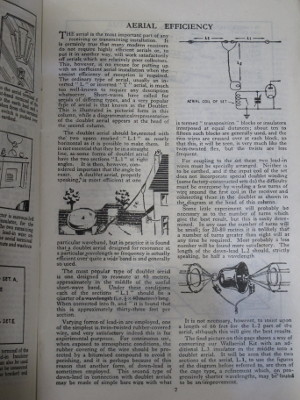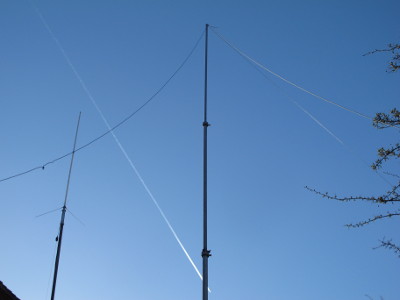
One of our local radio clubs (South Manchester Radio and Computing Club) has a very extensive library of old technical books donated by the members. Looking through it one evening I came across the Bulgin Radio Service Manual 1944-45 edition.
A few pages in I found an interesting article called “Aerial Efficiency” This described how to make a Doublet antenna for short wave listening using a selection of Bulgin radio components.
One line in the article stood out…”Varying forms of lead-in are employed, one of the simplest is twin-twisted rubber-covered wire, and very satisfactory indeed this is for experimental purposes.” It suggested that the rubber covered wire wasn’t good for outdoor use so ladder line was used for permanent installations.
Many years ago back in the 1970s I started my working life as an apprentice engineer for the local Electricity Board and I spend a few weeks with the house rewiring electricians removing the “twin-twisted rubber-covered wire” from a few houses. It didn’t last very long indoors and was fairly lethal with 240V AC applied to it as over time the rubber perished and started to crack up.
However the article got me thinking… What if I tried using modern materials for the “twin-twisted wire”. In the workshop I keep a few drums of 0.5mm and 0.8mm tri-rated cable from RS Components. This is a flexible copper wire of typically 16 or 32 strands but covered in a thick PVC insulation. It’s designed for use in industrial machinery and can withstand oil and other chemicals and a fair amount of heat. It’s called tri-rated as it’s meets the wiring regulations in Europe, USA and Canada and as it’s made in vast quantity it’s relatively cheap.
Twisting two wires together with a battery drill was a very easy and quick way of making a twin feeder. Entering the wire dimensions in an online calculator gave a characteristic impedance of 108 ohms for the 0.5mm wire so it should be possible to use it with a doublet antenna as the book suggested.
I soon whipped up a temporary doublet antenna to fit on the 9m Hilomast I use for antenna testing. The doublet elements are 8m long and the twisted pair feeder is 12m long to run down to the workshop. Two 20m long lengths of wire were used to make the feeder and the wire elements. The photo shows it on the mast just ty-wrapped on for testing. It certainly looks a lot better than ladder line and a lot cheaper too!
Using a Z Match tuning unit it could be tuned for an efficient match on all bands from 60m to 10m and would tune and match on 80m but it’s very short in terms of wavelength.
The most interesting observation is that because the majority of the electric field between the two wires in the feeder is within the PVC insulation the feeder can be run through a metal framed window closed onto the wire with no noticeable effect. I also tried running it on top of a metal cabinet again with no noticeable change to the tuner match or signal level. Try that with ladder line and it’s badly affected.
Testing with 150W on all bands through the tuner showed no adverse effects even when the metal window is closed on the feeder.
Of course any temporary antenna that works well becomes semi-permanent so it’s still up on the mast several weeks after the first test!